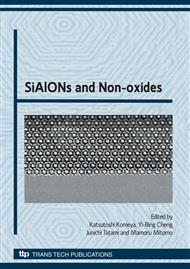p.207
p.211
p.217
p.221
p.225
p.227
p.231
p.235
p.239
Spark Plasma Sintering of Silicon Nitride-Boron Carbide Composites
Abstract:
Si3N4-B4C composites containing fine and coarse B4C particles were produced using Al2O3 and Y2O3 as sintering additives via spark plasma sintering (SPS) technique. Phase assemblages of the produced composites were determined by XRD analysis. Si3N4, B4C and in situ formed SiC, h-BN and Si phases were observed. Even when incorporated in significant amounts, B4C was consumed readily in the Si3N4 based system. Consequently, full densification of these composites was found to be a very difficult task due to the simultaneous in-situ reactions, even in fast sintering process. Electrical resistivity measurements carried out at room temperature indicated that addition of both fine and coarse B4C particles decreased the electrical resistivity by several orders of magnitude due to the formation of electrically conductive in-situ phases, mainly SiC and metallic Si.
Info:
Periodical:
Pages:
225-226
Citation:
Online since:
December 2008
Authors:
Price:
Сopyright:
© 2009 Trans Tech Publications Ltd. All Rights Reserved
Share:
Citation:


